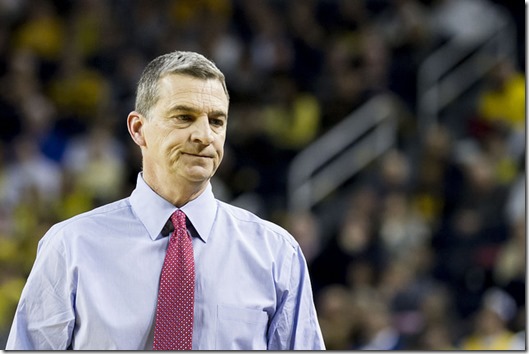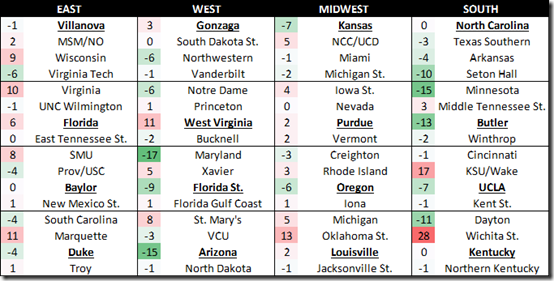 Maryland’s Mark Turgeon [Marc-Gregor Campredon – MGoBlog]
Maryland’s Mark Turgeon [Marc-Gregor Campredon – MGoBlog]
MGoBlog’s Tournament Sponsor is HomeSure Lending. NMLS 1161358.
March Madness is wonderful. Millions of people across the country will fill out a bracket, predicting winners for each game, hoping that they’ll be the one to pick the right upsets, and trust the right teams to make it to the Final 4. Of course, no amount of research is any guarantee of success, and part of the fun is the insane randomness that determines the course of these next few weeks. Still, becoming acquainted with the participants is key to making informed bracket choices, and I’ll be writing up a few posts with that in mind.
In order to sort out which teams are better or worse than where they’re seeded, I took the list of teams sorted by the committee 1-66, and I compared it to a composite computer ranking of tournament teams based on the average of Ken Pomeroy, Jeff Sagarin, and Bart Torvik’s metrics. I then calculated the difference between where a team should theoretically be ranked given their strength according to that composite ranking and where they actually wound up.
This is the resulting bracket:
The seven most overseeded teams (which are clustered in just two regions) are
- West #6 Maryland
- West #2 Arizona
- South #5 Minnesota
- South #4 Butler
- South #7 Dayton
- South #10 Seton Hall
- West #3 Florida St.
They’ll be discussed after the jump.
[JUMP]
Maryland
Seed Rank: 23 (6-seed). Computer Rank: 40 (10-seed). Round of 64 vs. Xavier (11); Round of 32 vs. Florida St. (3) / Florida Gulf Coast (14).
After years of computer rankings habitually overrating Bo Ryan’s Wisconsin team, they’ve started to habitually underrate Maryland: early-season success in close games – particularly in three one-point victories (two of which came against NCAA Tournament teams) – led to a wide gap between human and computer polls. The Terrapins started off the season with a 20-2 record and the advanced metrics were never particularly impressed; a very young team lost six of its last ten games, including a first round exit in a pseudo-home environment in the Big Ten Tournament against Northwestern.
Maryland the good fortune to wind up as the 6-seed in a region with a weak 2 (Arizona) and 3 (Florida State), and they have a veteran point guard – Melo Trimble – leading the show; they also have three freshmen playing significant roles – Kevin Huerter, Anthony Cowan, Justin Jackson – and none of those freshmen are NBA players. Their first round opponent, Xavier, lost their star point guard Edmond Sumner to a season-ending injury, so an upset there might not happen, but the computer rankings are very down on the potential for Maryland to make a long run.
Arizona
Seed Rank: 6 (2-seed). Computer Rank: 21 (6-seed). Round of 64 vs. North Dakota (15); Round of 32 vs. St. Mary’s (7) / VCU (10).
I was surprised to see how little the various advanced stats metrics liked Arizona; the Wildcats went 30-4, tied for the Pac-12 regular season title, won the conference tournament, and only lost to teams that eventually earned protected seeds. U of A only finished with the third-best efficiency in league games, but they finished a seed line ahead of Oregon and UCLA. Most of the Pac-12 is thoroughly mediocre (even though there are potential Final Four teams at the top), so that probably adversely impacted Arizona’s statistical profile. The committee judged their resume fairly though, giving them a 2-seed out West, and manageable potential matchups against Florida St. and Gonzaga in the Sweet 16 and Elite 8.
As is custom for him in Tucson, Sean Miller has a young and talented team. Freshmen Lauri Markkanen, Rawle Atkins, and Kobi Simmons have played significant roles this season and sophomore Allonzo Trier has made an impact after a PED suspension kept him ineligible for most of the season. Markkanen is a likely one-and-done lottery pick from Finland and one of the most efficient players in the country – the 7-footer shoots 54% on twos, 43% on threes, and 82% from the line. Arizona’s solid, but not exceptional, on both sides of the floor, and boast one of the tallest teams in the country.
Minnesota
Seed Rank: 18 (5-seed). Computer Rank: 33 (9-seed). Round of 64 vs. Middle Tennessee St. (12); Round of 32 vs. Butler (4) / Winthrop (13).
It’s been quite the turnaround for Minnesota, which has improved its win total by 16 and finished with a protected seed in the Big Ten Tournament. Despite having a meh non-conference schedule, the Golden Gophers successfully gamed the RPI and find themselves a few seed lines higher than they should be. With Akeem Springs’s Big Ten Tournament injury, Richard Pitino was forced to go to a six-man rotation in the semifinals against Michigan; the Gophers have talent, but not depth, and the tactical acumen of Pitino is very much an open question. Minnesota finished with thee second-best seed in the Big Ten. They weren’t the second-best team in the Big Ten.
Before the injury to Springs late in the BTT win over Michigan St., Minnesota had been playing quite well, winning 9 of their last 10, including that game after a 5-game skid in January. Middle Tennessee St. will be a popular 5 / 12 upset pick; the Blue Raiders dominated their conference after returning most of their key players from a team that pulled a historic upset over Michigan St. in the tournament last season. MTSU is one of the best under-the-radar mid-major teams in the country and should be a tough out for the Gophers. Whoever wins that game, will likely play…
Butler
Seed Rank: 13 (4-seed). Computer Rank: 26 (7-seed). Round of 64 vs. Winthrop (13); Round of 32 vs. Minnesota (5) / Middle Tennessee St. (12).
…Butler, another team that’s overseeded. The Bulldogs had an early exit from the Big East Tournament, but they racked up some good wins over the course of the season: they swept #1 overall seed Villanova, defeated Arizona at a neutral site, beat Marquette on the road, and took care of Vanderbilt and Northwestern in the non-conference portion of the season. Butler did record a few losses against non-tournament teams, most notably a one-point loss to lowly Indiana State, but a mostly great non-conference showing and a second-place finish in the Big East was good enough to get them a 4-seed.
Junior wing Kelan Martin is the go-to guy for the Bulldogs, an inside-outside threat leading the team in shot attempts by a wide margin. He’s joined by Andrew Chrabascz on the wing, a versatile player who does most of his damage by drawing fouls. Sixth man freshman Kamar Baldwin provides energy and shot-making off the bench, and veteran point guard and North Carolina State transfer Tyler Lewis is a low-usage set-up man with one of the best individual offensive ratings in the country.
Butler’s opening round matchup (Winthrop) is much easier than Minnesota’s (MTSU), but if you’re looking for a spot to put a double-digit seed in the Sweet 16, the MTSU Blue Raiders might be a good choice – they’d face the equivalent of a 9- and 7-seed to get there.
Dayton
Seed Rank: 28 (7-seed). Computer Rank: 39 (10-seed). Round of 64 vs. Wichita St. (10); Round of 32 vs. Kentucky (2) / Northern Kentucky (15).
The Flyers have seen a considerable amount of NCAA Tournament success under head coach Archie Miller; they made it to the Elite 8 in 2014, won a First Four game and made it to the Round of 32 in 2015, and have made it to the tournament four seasons in a row. Dayton only lost one home game all season – to fellow mid-major stalwart St. Mary’s – and won the Atlantic 10 regular season title running away, but a season-ending loss to George Washington and a loss to Davidson in the first round of the conference tournament signal that the Flyers may be hitting a rough patch after a nine-game winning streak that extended from January to March.
Unfortunately for Dayton, they drew perhaps the worst first-round matchup in the entire field, another mid-major that’s experienced recent March success: Wichita St. The Shockers avoided the bubble by winning the Missouri Valley Tournament, but they wound up as a 10-seed after finishing tenth in the aggregate computer rankings. Wichita St. would play Kentucky in the Round of 32 and could be an intriguing Cinderella pick. At the very least, Dayton is deeply unlucky to see them in the 7 / 10 game.
Seton Hall
Seed Rank: 34 (9-seed). Computer Rank: 44 (11-seed). Round of 64 vs. Arkansas (8); Round of 32 vs. North Carolina (1) / Texas Southern (16).
Seton Hall is one of a handful of teams that played its way into the tournament late in the season; after a 22-point home loss to Villanova on February 18th, they were just 16-10 (6-8 Big East), but after a five-game winning streak and heartbreaking loss to the Wildcats in the Big East Tournament, the Pirates were safely in the field of 68. At one point, they lost five of six games, but they recovered over the second half of conference play and weren’t really at risk of missing the field by the end of the season. Still, the computer ranking composite considers the Pirates to be one of the worst at-large teams to have received a bid.
In any case, Seton Hall is unlikely to advance very far in the tournament. Their opponent in the 8 / 9 game (Arkansas) isn’t anything special, but North Carolina looms as the Round of 32 opponent and the Tar Heels’ size inside could pose problems for a team that only has one player over 6’6 – excellent junior big man Angel Delgado – among their five players with the most playing time. Even if they do beat Arkansas, getting to the Sweet 16 would be quite difficult since getting there means that the Pirates (who are a team with the quality of an 11-seed) would have to beat one of the national title favorites.
Florida St.
Seed Rank: 10 (3-seed). Computer Rank: 19 (5-seed). Round of 64 vs. Florida Gulf Coast (14); Round of 32 vs. Maryland (6) / Xavier (11).
After a four-year NCAA Tournament drought under longtime head coach Leonard Hamilton, the Seminoles exceeded expectations this season, winning 25 games and finishing tied for second in an ultra-competitive ACC alongside Louisville and Notre Dame. Florida St. has a highly touted outside scorer (sophomore Dwayne Bacon), a versatile defensive stopper (Xavier Rathan-Mayes, who also has an excellent assist-to-turnover ratio), a tantalizing one-and-done freshman (Johnathan Isaac) whose skill at 6’10 will get him drafted in the lottery, and a host of other spectacular athletes, including two rotation centers over 7-feet tall.
While FSU has cooled off as the season has gone on – they started off 18-2 with wins over Virginia, Duke and Louisville before finishing 7-6 down the stretch with few great wins – they landed in a nice spot: as the 3-seed in the West, they’d have to play Maryland and Arizona to make the Elite 8 if chalk holds – the two highest teams on this list. FSU only ranks 19th in the computer ranking, but Arizona is 21st. If you’re looking for a sleeper in that part of the bracket, 7-seed St. Mary’s could be a worthy choice.


















